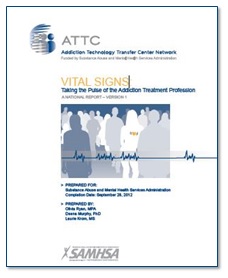
Todd Molfenter, PhD, is an assistant scientist at the University of Wisconsin–Madison College of Engineering and co-deputy director of NIATx. He has been a principal investigator and deputy director on multiple grants and has spent the last 20 years studying, planning, and leading organizational and individual change efforts. Molfenter worked with Victor Capoccia to create the Health Reform Readiness Index (HRRI), an online tool that behavioral health organizations can use to gauge their level of preparedness for the changes accompanying parity and reform legislation, changes to state budgets, and the increasing emphasis on performance accountability. In the Q&A that follows, Molfenter talks about developing the tool and the results of surveys completed by more than 400 organizations over two separate time periods.
TM: The inspiration was two-fold. In 2010 NIATx led a project called the Accelerating Reform Initiative (ARI), which was funded by the Robert Wood Johnson Foundation and the Center for Substance Abuse Treatment at SAMHSA. Victor Capoccia was part of the research team for ARI. The purpose of the project was to give behavioral health organizations tools for responding to changes such as parity legislation, integration of primary care and specialty care, and decreased grant funding.
In ARI, we observed that some organizations were responding to both anticipated changes and changes already underway, but others were not. Our thought was that reform was going to require significant adjustments for organizations in delivering clinical care and conducting their businesses. Victor Capoccia had done research on how universal coverage had been implemented in Massachusetts, and he identified certain things that organizations there had done to adapt to the change. He suggested that we should catalog those activities that helped Massachusetts organizations and compile them into a tool that organizations in other states could use to conduct a self-assessment. In addition, the 22 organizations participating in ARI had plenty of suggestions.
TM: Behavioral healthcare providers may not still be completely sure of the impact of the legislation in their respective states. But the national trend toward fee-for-service and managed care—which aims to lower the costs and improve quality of care—is requiring behavioral healthcare leaders to develop the same competencies they’ll need to be prepared for full implementation of healthcare reform.
These competencies include understanding and implementing health information technology, especially electronic health records (EHR) to improve quality, contain costs, and give patients greater control of their personal health. Integration with primary care, another component of the ACA, is already happening, as behavioral health works to operate in conjunction with the broader health system.
The movement toward managed care and fee-for-service reimbursement has been accompanied by changes in state funding. Behavioral healthcare providers are learning to expand their payer mix and their business skills. They are developing new systems for billing, managing accounts receivables, and reducing claim denials. Providers will need to have these systems firmly in place to accommodate both the Medicaid expansion anticipated with ACA and the Health Insurance Marketplaces.
Changes in state funding are requiring providers to help their patients determine their eligibility for public or private insurance coverage. Efficient enrollment systems will also be essential with Medicaid expansion and the marketplaces. These changes in funding and reimbursement are also driving the need for a workforce with the credentials and clinical competence that payers require. State governments and managed care increasingly require documentation that demonstrates that quality indicators are being tracked, as well as plan to continuously improve performance.
The funding environment is changing rapidly and whether or not the ACA is fully implemented as designed, behavioral health care providers who are working on these areas are setting themselves up for success.
TM: The study team looked at results of the HRRI completed between October 1, 2010 and July 15, 2011, and then later, for the period covering September 1, 2011, through September 30, 2012.
What came as a surprise was how the upcoming changes to payment mechanisms for addiction treatment seemed to influence many of the HRRI results. My background is in working for hospitals and large specialty clinics, and I observed something similar in physicians’ practices in the 1990s with the advent of managed care. At that time, physician practices also had to learn how to bill for their services and to demonstrate quality. It’s very similar to what addiction treatment providers are going through now. And now many of the projects underway to help addiction treatment providers are drawing from lessons we learned from general healthcare.
TM: When we analyzed the HRRI results for the first time period, we saw that the majority of organizations scored lowest in readiness for electronic health records and workforce development. Both implementing EHR and developing the workforce require a financial investment that many organizations may not have. Organizations with large budgets were much more likely to have resources for an EHR and workforce development.
The analysis of surveys completed from September 2011 through September 2012 showed an improved result in the number of organizations that were working on integrating behavioral health and primary care. The percentage of behavioral health organizations that offer primary care increased from 6% to 15% from 2010 to 2012. Some organizations were working on co-location—adding a primary care clinic within the specialty care clinic, or vice versa. Other organizations were starting to use telemedicine, or creating shared referral relationships—where a specialty care clinic and primary care clinic refer patients to each other.
We also saw an increase in business capacity. Organizations that had relied solely on grant funding decreased from 24 percent to 20 percent. There was an increase in organizations with funding from third-party payers—from 10.8 percent to 26 percent.
 TM: In workforce development, we were looking for information on how many organizations were able to recruit and retain staff with the credentials typically required by managed care or health insurance companies. We found that organizations understand that the need for credentialed clinical workforce, but that current reimbursement rates do not support the ability to offer salaries that attract credentialed staff. This confirms the findings of the ATTC report on workforce development,
TM: In workforce development, we were looking for information on how many organizations were able to recruit and retain staff with the credentials typically required by managed care or health insurance companies. We found that organizations understand that the need for credentialed clinical workforce, but that current reimbursement rates do not support the ability to offer salaries that attract credentialed staff. This confirms the findings of the ATTC report on workforce development,
Vital Signs: Taking the Pulse of the Addiction Treatment Profession. The Vital Signs report is a great place to start if you want to focus your attention on developing your workforce, along with the many other web resources and trainings that the ATTC offers.
Workforce development is also be one of the main topics that Victor Capoccia and I will address in the upcoming iTraining, (Thursday, November 21, 2:00pm – 3:30pm EDT), with examples from a couple of states that have workforce development projects currently underway.
If you haven’t yet embarked on making the transition to this new environment, or if you’re not sure where to begin, take a look at an assessment tool like the HRRI. It’s just one of many tools available that are designed to help you identify your organization’s strengths and weaknesses in preparing for the transformation of the behavioral healthcare field.
______________________________________________________________________________
Presenters: Todd Molfenter, PhD & Victor Capoccia, PhD